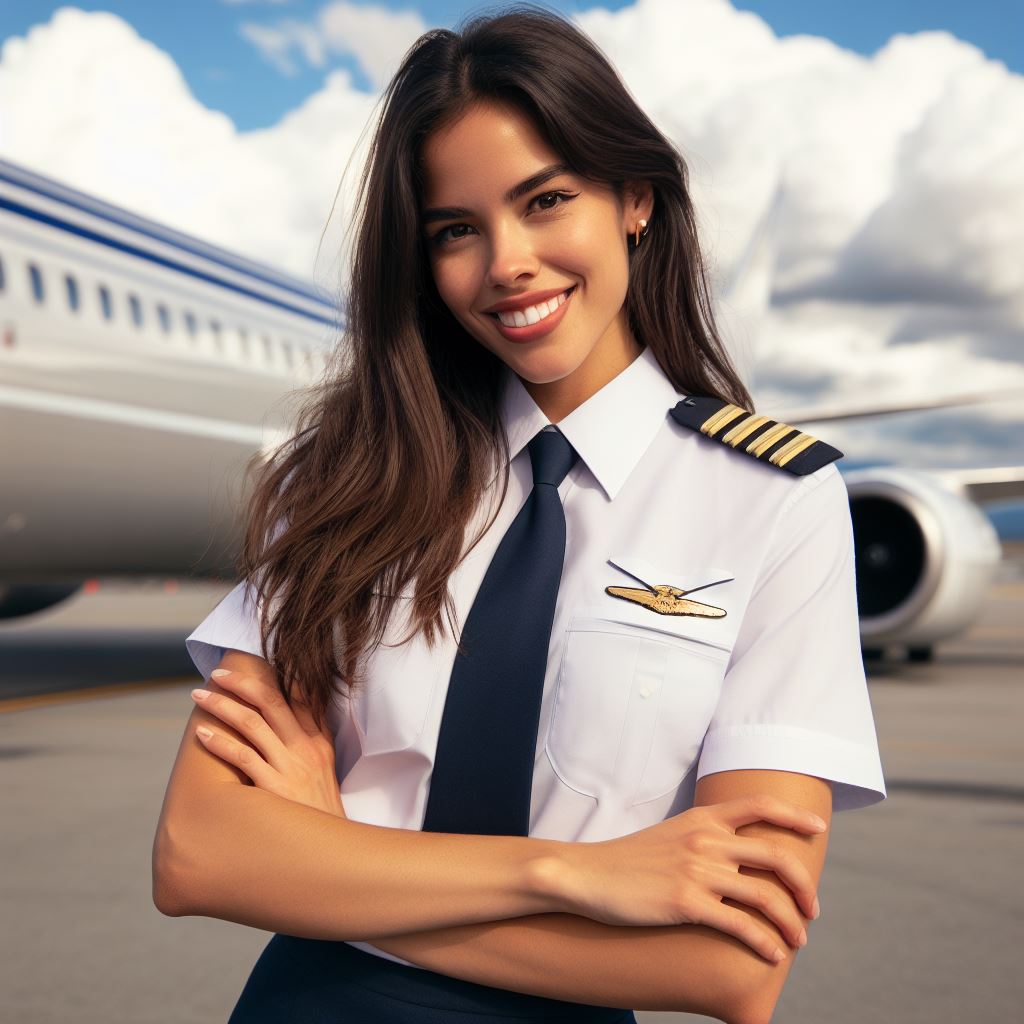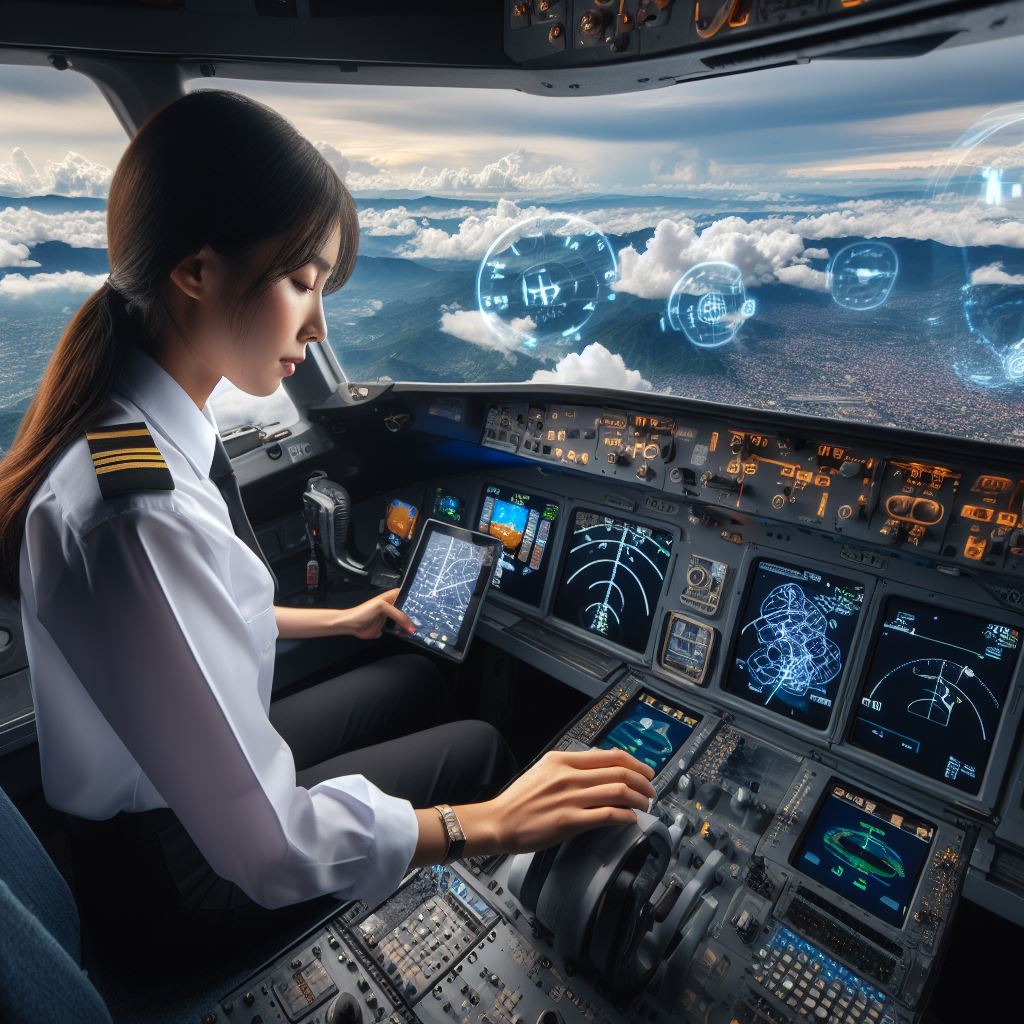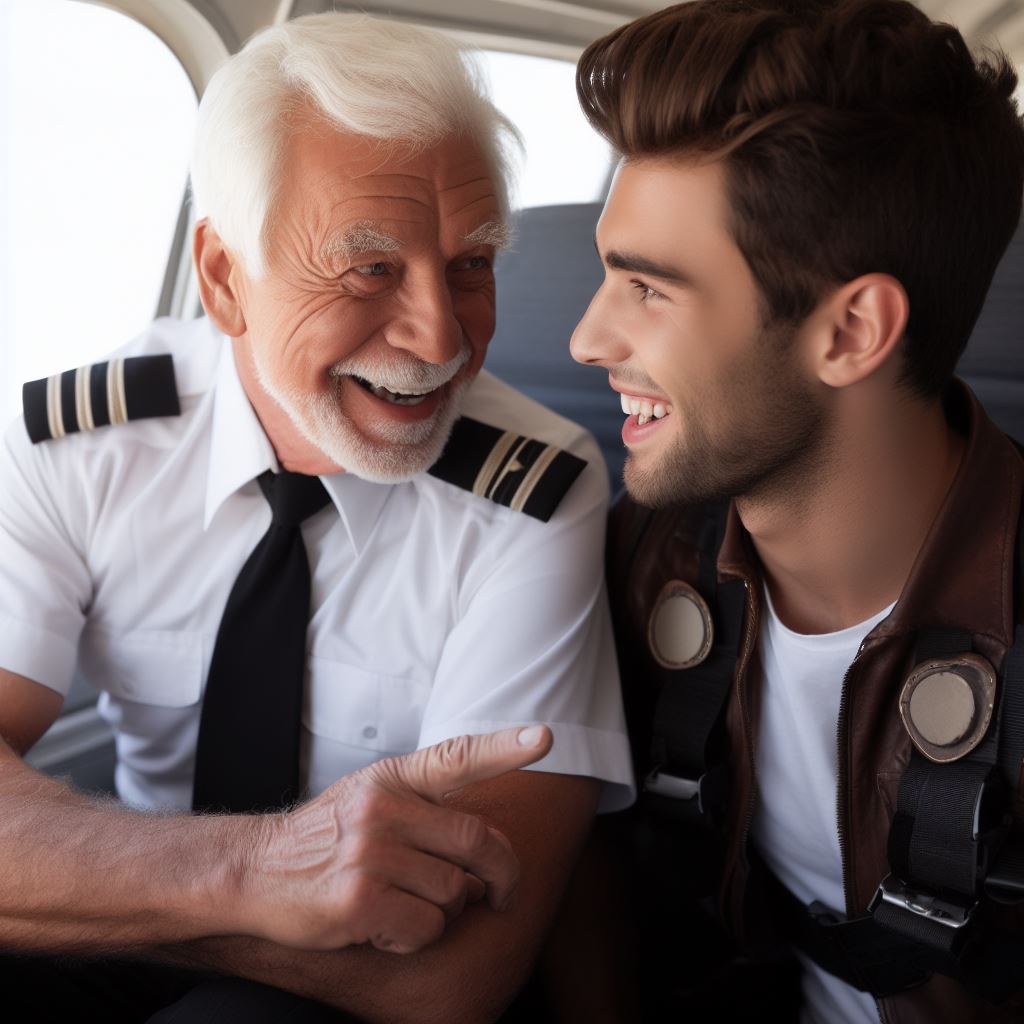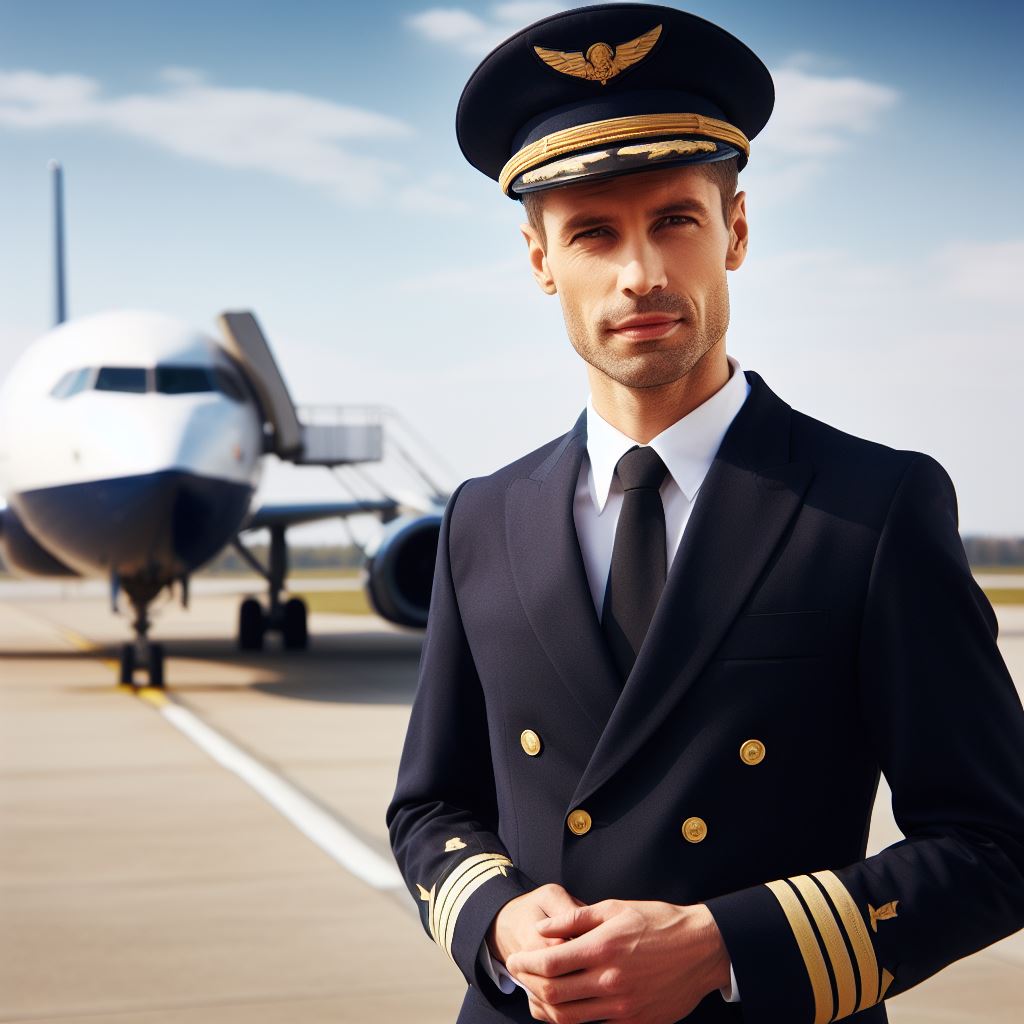Introduction
Airline pilots play a crucial role in the aviation industry, ensuring the safe and efficient transportation of passengers and cargo.
Airline pilots are pivotal, ensuring safe and efficient air travel, navigating complex routes, and prioritizing passenger safety.
Their expertise and precision are fundamental to the reliability and success of the aviation industry.
Pilots play a critical role in upholding stringent safety standards, mitigating risks, and adapting to dynamic conditions.
As leaders in the cockpit, they manage crew coordination, communication, and decision-making, contributing significantly to the overall operational effectiveness of airlines.
The continuous training and experience of airline pilots not only guarantee the well-being of passengers but also uphold the industry’s reputation for reliability and professionalism.
Their competence in handling various aircraft and scenarios positions them as indispensable assets, highlighting the essential role they play in the dynamic and ever-evolving aviation landscape.
In this section, we will explore a day in the life of a US-based airline pilot.
Preparing for the Day
Being a US-based airline pilot requires exceptional readiness before each flight.
It is essential for the pilot to be fully prepared to ensure a safe and smooth journey for the passengers and the crew.
Let’s dive into the steps involved in the pilot’s preparation:
1. Pre-flight Briefing and Checklist Procedures
Before taking off, an airline pilot goes through a meticulous pre-flight briefing and checklist procedures. This stage is critical to ensure that no important aspects are overlooked.
The pilot must carefully review the aircraft’s condition and systems, as well as the task-specific checklists.
During the pre-flight briefing, the pilot receives crucial updates regarding the flight, such as weather conditions, airspace restrictions, and any other relevant information.
It is crucial for the pilot to stay informed and well-prepared to handle any possible challenges.
Following the briefing, the pilot goes through a comprehensive checklist.
This checklist covers various aspects, including fuel quantity, engine performance, electrical systems, navigation equipment, and safety features.
The pilot must meticulously follow the checklist, ticking off each item, ensuring that everything is functioning correctly.
2. Reviewing Weather Conditions and Flight Plans
Another important responsibility of the pilot is to review the weather conditions and flight plans.
The pilot must pay close attention to weather reports, including forecasts for various airports along the route and at the destination.
Transform Your Career Today
Unlock a personalized career strategy that drives real results. Get tailored advice and a roadmap designed just for you.
Start NowThis allows them to anticipate any adverse weather conditions, such as heavy rain, thunderstorms, or strong winds.
The pilot’s review of the flight plan involves examining the designated route, altitude, and waypoints.
They need to ensure that the flight plan is compliant with air traffic control directives and any airspace restrictions.
Additionally, the pilot considers alternate airports in case of emergencies or unexpected closures.
By reviewing the weather conditions and flight plans, the pilot can make informed decisions concerning necessary adjustments or alternative routes.
It enables them to plan and execute the flight in the safest and most efficient manner possible.
Overall, the readiness of a US-based airline pilot before each flight is of utmost importance.
The pre-flight briefing and checklist procedures ensure that all necessary preparations are carefully addressed, leaving no room for oversight.
Additionally, the pilot’s responsibility in reviewing weather conditions and flight plans allows for proactive adjustments and reduces potential risks.
Being well-prepared sets the stage for a successful flight, prioritizing the safety and satisfaction of the passengers and crew.
Arrival at the Airport
- Arriving at the airport at least two hours before the scheduled departure time is crucial.
- After parking his/her car, the pilot proceeds to the airport terminal.
- The pilot is required to show various forms of identification and passes through security screening.
- This process includes passing through metal detectors and having personal items scanned.
- Once through security, the pilot heads to the crew check-in counter.
- Here, the pilot meets the flight crew, which includes the co-pilot and flight attendants.
- They discuss the flight plan, weather conditions, and any potential issues that may arise.
- The ground staff informs the pilot of any last-minute changes or updates to the flight schedule.
- Being on time is crucial, as any delays can affect the overall efficiency of the flight operation.
- The pilot understands the importance of a smooth and timely boarding process.
- Precise pre-flight preparations ensure safety, punctuality, and passenger satisfaction.
- Before boarding, the pilot double-checks all necessary documents, including the flight plan.
- They also inspect the aircraft, paying close attention to its maintenance and overall condition.
- Additionally, the pilot verifies that fuel levels are sufficient for the flight duration.
- Once satisfied with the aircraft’s condition, the pilot proceeds to the boarding area.
- Assuming a professional and approachable demeanor, the pilot greets passengers and flight attendants.
- The pilot ensures that passengers are comfortably settled, stowing their carry-on luggage.
- They work closely with the flight attendants to ensure a smooth boarding process.
- Often, the pilot takes the opportunity to address the passengers, providing pertinent flight information.
- This includes the estimated flight duration, weather conditions, and anticipated arrival time
Being a US-based airline pilot demands strict adherence to arrival times, security procedures, and effective communication with the flight crew and ground staff.
The pilot’s punctuality sets the foundation for a successful boarding and pre-flight preparation process.
By prioritizing safety and passenger satisfaction, the pilot establishes trust and confidence in the passengers’ minds, ensuring a smooth and enjoyable flight experience.
Aircraft Inspection
Pilot’s role in conducting a thorough inspection of the aircraft –
As part of their daily routine, airline pilots play a crucial role in conducting a thorough inspection of the aircraft.
This task is essential to ensure the safety and proper functioning of the plane before every flight.
One of the pilot’s responsibilities during the aircraft inspection is to check the navigation systems.
By verifying the accuracy of these systems, the pilot can ensure that the plane will navigate through the intended route without any issues.
This step is crucial to guarantee a smooth and efficient flight.
Purpose of checking navigation systems, fuel levels, and safety equipment
In addition to the navigation systems, pilots also have to inspect the fuel levels.
They need to ensure that there is enough fuel for the planned flight, considering factors such as the distance, altitude, and weather conditions.
Transform Your Career Today
Unlock a personalized career strategy that drives real results. Get tailored advice and a roadmap designed just for you.
Start NowThis examination prevents any unforeseen fuel shortages during the journey, ensuring a safe and uninterrupted flight.
Another essential aspect of the aircraft inspection is the examination of safety equipment.
Pilots need to assess the presence and functionality of items such as life vests, first aid kits, and emergency exits.
This examination guarantees that all necessary safety measures are in place to address any unexpected situations that may arise during the flight.
Collaboration between the pilot and the maintenance crew
To perform these inspections effectively, pilots collaborate closely with the maintenance crew.
This collaboration ensures a comprehensive evaluation of the aircraft’s condition.
The maintenance crew provides valuable assistance by conducting in-depth inspections and addressing any technical issues that may arise.
During the inspection process, pilots communicate with the maintenance crew to relay their observations and concerns.
This collaboration enhances safety by allowing both parties to share their expertise and ensure that all components are in optimal condition.
By actively participating in this partnership, pilots contribute to the overall safety and efficiency of air travel.
The pilot’s role in aircraft inspection goes beyond a mere checklist.
It requires attention to detail, knowledge of the plane’s systems, and the ability to recognize potential problems.
By actively engaging in this process, pilots take an active role in safeguarding the well-being of both passengers and crew members.
In fact, the pilot’s involvement in the aircraft inspection is instrumental in guaranteeing a safe and successful flight.
Their responsibility ranges from checking navigation systems and fuel levels to examining safety equipment.
Collaborating with the maintenance crew further ensures a comprehensive evaluation of the aircraft.
Through their diligent efforts, pilots contribute to the overall safety and efficiency of air travel
Preparing the Cockpit
1. The pilot plays a crucial role in setting up the cockpit instruments and controls accurately
- Airline pilots are responsible for ensuring that all instruments and controls are functioning properly.
- They must check the altimeters, airspeed indicators, attitude indicators, and other essential instruments.
- The pilot also ensures that the control surfaces, such as the ailerons and rudder, are responsive.
- Any malfunctioning instruments or controls must be reported immediately for rectification.
2. Communication equipment functionality is another important aspect the pilot needs to ensure
- Pilots must verify the functionality of radios, transponders, and other communication equipment.
- They follow a meticulous procedure to check the clarity and effectiveness of the communication systems.
- This includes verifying frequencies, testing microphones and headsets, and ensuring proper volume control.
- Reliable communication is essential for maintaining contact with air traffic control and other aircraft.
3. Completion of pre-flight checklists and briefings is an integral part of cockpit preparation.
- Before each flight, pilots have a series of checklists to go through to ensure proper aircraft readiness.
- They inspect the aircraft’s exterior, including the wings, engines, and any visible signs of damage.
- The pre-flight checklist also includes verifying fuel levels, hydraulic systems, and electrical systems.
- Pilots conduct a thorough briefing to discuss flight plans, weather conditions, and any potential hazards.
4. In the cockpit, pilots undergo a before-start checklist to ensure all critical systems are set up.
- They verify the proper alignment of flight instruments, adjust seats, and check the aircraft’s weight and balance.
- Pilots also configure the autopilot system, set up navigation aids, and input the flight plan into the flight computer.
- Completing the before-start checklist ensures a smooth start-up process to prepare for departure.
- Throughout the entire process, pilots maintain clear communication with the cabin crew and ground staff.
5. During this phase, pilots ensure the safety of themselves, the aircraft, and all onboard passengers.
- They follow standard operating procedures and adhere to safety regulations in every aspect of cockpit preparation.
- The meticulous examination of instruments, controls, and communication equipment guarantees safe operation.
- By completing pre-flight checklists and briefings, potential issues are identified and addressed beforehand.
- Preparing the cockpit thoroughly contributes to a successful and safe flight for all.
As a US-based airline pilot, setting up the cockpit instruments and controls, ensuring the functionality of communication equipment, and completing pre-flight checklists and briefings are fundamental responsibilities.
By meticulously carrying out these tasks, the pilot ensures that the aircraft is ready to operate safely and efficiently.
Every step of the preparation process is crucial for a successful flight and the overall safety of everyone onboard.
Transform Your Career Today
Unlock a personalized career strategy that drives real results. Get tailored advice and a roadmap designed just for you.
Start NowTakeoff and Climb
In this section, we will explore the various responsibilities of a US-based airline pilot during takeoff procedures and the importance of monitoring the aircraft’s performance during climb.
1. Pilot’s Responsibilities During Takeoff Procedures
- Perform pre-flight checks and ensure all systems are functioning properly.
- Confirm the aircraft weight and balance, considering factors such as fuel, passengers, and cargo.
- Calculate takeoff speeds, including V1, VR, and V2, and verify safety margins.
- Coordinate with the flight attendants to ensure all passengers are ready for departure.
- Engage in briefings with the co-pilot to discuss the takeoff plan and verify emergency procedures.
- Apply full power to the engines and monitor their performance during acceleration.
2. Collaboration with the Co-Pilot and Communication with Air Traffic Control
- Maintain effective communication with the co-pilot throughout the takeoff and climb phases.
- Confirm proper operating procedures and cross-check each other’s actions and callouts.
- Follow instructions from air traffic control, including clearances for takeoff and initial climb.
- Inform air traffic control of any deviations or changes in the flight plan.
- Coordinate with air traffic control for traffic separation and any required altitude or heading adjustments.
- Adhere to radio communication protocols and use concise and precise phraseology.
3. Importance of Monitoring the Aircraft’s Performance During Climb
- Maintain a constant scan of flight instruments, ensuring the aircraft is climbing at the desired rate.
- Monitor engine parameters, such as thrust, temperatures, and fuel flow, for optimal performance.
- Verify that the autopilot is correctly engaged, if applicable, and monitor its operation.
- Ensure the aircraft is tracking the assigned route and reaching the cleared altitude.
- Monitor weather conditions, including turbulence or icing, and adjust the flight path if necessary.
- Assess the cabin environment, paying attention to pressurization and temperature control.
In essence, the takeoff and climb phases require the pilot’s full attention and proficiency to ensure a safe and efficient flight.
Collaborating with the co-pilot and maintaining effective communication with air traffic control are crucial elements in this process.
Moreover, monitoring the aircraft’s performance during climb ensures optimal operation and adherence to the planned flight path.
By diligently executing their responsibilities, US-based airline pilots contribute to the overall success of each flight.

In-flight Operations
During the flight, airline pilots engage in a range of routine tasks to ensure a safe and smooth journey for everyone on board.
- Perform pre-flight checks: Before takeoff, pilots conduct a thorough inspection of the aircraft’s systems and controls.
- Review flight plans: They carefully study the flight route, including air traffic control instruction, navigational waypoints, and weather conditions.
- Communicate with air traffic control (ATC): Pilots maintain constant communication with ATC to ensure they follow the correct flight path and avoid any potential conflicts.
- Monitor systems: Pilots continuously monitor onboard systems to detect any anomalies or malfunctions that may impact the flight’s safety and performance.
- Check navigation: They cross-check their position using various navigation tools, such as GPS, radio beacons, and instrument landing systems.
- Monitor weather conditions: Pilots keep a close eye on weather patterns, including turbulence, storms, and icing, to adjust the flight path if necessary.
- Monitor fuel consumption: They track fuel usage to ensure the aircraft has enough fuel for the planned journey and any contingencies.
- Calculate performance: Pilots constantly assess the aircraft’s performance, taking into account factors like altitude, speed, and weight to optimize fuel efficiency.
- Communicate with cabin crew: They maintain regular communication with the cabin crew, providing updates on the flight’s progress and any necessary instructions.
- Ensure passenger comfort: Pilots also play a role in ensuring passenger comfort by coordinating with the cabin crew to address any concerns or issues.
- Manage emergency situations: In the event of an emergency, pilots are trained to quickly assess the situation and take appropriate actions to ensure the safety of everyone on board.
- Update flight records: Pilots maintain a record of their flight activities, including fuel usage, flight time, and any incidents or abnormalities encountered.
- Conduct in-flight checks: They periodically assess the aircraft’s performance during the flight, including engine performance, flight controls, and instrument readings.
- Stay alert and focused: Pilots must maintain a high level of concentration throughout the flight, continuously scanning for potential hazards and reacting promptly if needed.
- Communicate with other pilots: Pilots often exchange information with other pilots flying in the same airspace to enhance situational awareness and share important updates.
- Adhere to standard operating procedures: Pilots strictly follow established protocols and procedures to maintain consistency and safety across all flights.
Effective communication is crucial for airline pilots in carrying out their tasks and ensuring a successful flight
- Communication with the cabin crew: Pilots maintain open lines of communication with the cabin crew to address any safety concerns, turbulence, or updates regarding the flight.
- Communication with passengers: Pilots make important announcements to passengers, providing information about the flight’s progress, weather conditions, and any potential delays.
- Communication with air traffic control: Pilots relay crucial information, such as altitude changes, flight plan adjustments, and emergency situations, to air traffic control for appropriate guidance.
By actively monitoring systems, navigation, and weather conditions, pilots can ensure a safe and efficient flight experience.
Effective communication with the cabin crew and passengers further enhances the overall journey, making it a collaborative and comfortable experience for everyone on board.
Read: Exploring Different Flying Careers: Beyond Airlines
Navigation and Descend
As an airline pilot, part of my job is to ensure smooth navigation and make necessary mid-flight adjustments.
Let me detail my responsibilities during this crucial phase of the journey.
1. Pilot’s Responsibilities during Navigation and Mid-flight Adjustments
- I constantly monitor the aircraft’s position using advanced navigation systems and instruments.
- It is my duty to assess weather conditions and make necessary adjustments to avoid turbulence or unfavorable air conditions.
- I collaborate with the air traffic control to receive real-time updates on potential traffic conflicts or deviations from the planned route.
- Based on the information received, I communicate with the co-pilot and the cabin crew to ensure passenger safety and comfort.
- In case of emergencies or unexpected situations, I am responsible for making immediate decisions to maintain flight safety.
2. Maintaining Proper Altitude and Course Adherence
- I closely monitor the altimeter, airspeed, and heading indicators to ensure the aircraft stays on the designated altitude and course.
- By cross-referencing with navigation charts and radio aids, I make necessary corrections to keep the aircraft on the intended route.
- If strong winds or weather conditions cause deviations, I calculate new headings and communicate with air traffic control for necessary clearances.
- During this phase, the co-pilot assists in monitoring the aircraft’s position and cross-checking navigation information.
- Constant communication and coordination with the air traffic control are vital to maintain separation from other aircraft and conform to airspace regulations.
3. Procedures for Initiating the Descend towards the Destination Airport
- Prior to initiating the descent, I cross-check the latest weather reports and information from the destination airport.
- Once in contact with air traffic control, I request descent clearance and acknowledge any specific procedures or altitude restrictions.
- I initiate a gradual descent, typically at a rate of 500-1,500 feet per minute, depending on the distance and weather conditions.
- Throughout the descent, close monitoring of the aircraft’s speed, rate of descent, and altitude is essential.
- I coordinate with the cabin crew to prepare the passengers for landing, ensuring proper seatbelt usage and providing necessary announcements.
Navigating the skies and managing the descent towards the destination airport requires precise calculations, constant vigilance, and effective communication.
As an airline pilot, I take immense pride in fulfilling these responsibilities and ensuring a safe and comfortable journey for all onboard.
Read: Essential Skills Every Pilot Needs to Succeed
Landing and Taxiing
- During approach and landing procedures, the pilot is responsible for maintaining control and ensuring a smooth touchdown.
- The pilot coordinates with the co-pilot to execute the landing, with one handling the controls and the other monitoring.
- Clear communication with air traffic control is crucial during approach and landing to ensure a safe and efficient operation.
- The pilot must follow the instructions given by air traffic control, acknowledging and complying with any changes or updates.
- Collaboration with the co-pilot is essential in sharing information and double-checking critical parameters such as airspeed and altitude.
- The pilot and co-pilot continuously assess the runway conditions and adjust the approach accordingly to ensure a safe landing.
- Once the aircraft touches down, the pilot takes control of the thrust reversers and initiates the deceleration process.
- The pilot ensures the aircraft is on the centerline of the runway and continues to apply braking until reaching a safe taxi speed.
- At this point, the pilot uses the rudder pedals and nosewheel steering to navigate the aircraft from the runway to the taxiway.
- The pilot follows the instructions from the ground controller to reach the assigned gate or parking area.
- Clear communication with ground control is necessary for a smooth and efficient taxiing process after landing.
- The pilot must adhere to the taxiway markings, signs, and lights to maintain safe distances from other aircraft.
- During taxiing, the pilot ensures the aircraft remains clear of any obstacles and maintains situational awareness.
- The pilot closely monitors the aircraft’s speed, using the brakes as necessary to maintain a safe taxi speed.
- If there are any unexpected issues or abnormalities during taxiing, the pilot promptly reports them to air traffic control.
- Once the aircraft reaches the assigned gate or parking area, the pilot follows the ground controller’s guidance for proper positioning.
- The pilot ensures that the aircraft’s engines are shut down and instructs the passengers to remain seated until further instructions.
- After the aircraft is parked, the pilot completes the necessary post-landing checklists and coordinates with the cabin crew for passenger disembarkation.
- The pilot remains vigilant during the entire landing and taxiing process, prioritizing safety and efficient operation of the aircraft.
- Throughout the day, multiple landings and taxiing procedures may occur, requiring the pilot to maintain focus and professionalism.
- Landing and taxiing are crucial parts of a pilot’s duties, requiring coordination, communication, and attention to detail for a successful operation
Read: Common Misconceptions About Pilots Debunked!
Post-flight Duties
After the completion of a flight, the pilot is responsible for several post-flight duties.
These duties involve ensuring the safety of the aircraft and maintaining effective communication with various parties involved.
Additionally, the pilot plays a crucial role in reporting any incidents or observations encountered during the flight.
- Conducting aircraft inspections: The pilot must conduct a thorough inspection of the aircraft after landing to identify any damage or issues that may have occurred during the flight.
- Communicating with ground staff: The pilot must liaise with ground staff to coordinate various activities, such as refueling the aircraft, unloading baggage, and performing maintenance checks.
- Collaborating with cabin crew: Effective communication with the cabin crew is essential to ensure the smooth disembarkation of passengers and the completion of necessary safety procedures.
- Attending post-flight briefings: Pilots participate in post-flight briefings with the cabin crew and ground staff to discuss any important information related to the flight, including operational issues or passenger feedback.
- Documenting incidents or observations: In case of any incidents, malfunctions, or unusual occurrences during the flight, the pilot is responsible for promptly reporting and documenting them in an incident report.
This information is crucial for further investigation and improvement of safety procedures. - Reviewing flight logbooks: Pilots need to review the flight logbooks, which contain essential details such as fuel consumption, maintenance issues, and other operational parameters.
These logbooks provide vital information for future reference and planning. - Completing paperwork: Pilots are required to fill out various paperwork after each flight, including flight reports, flight time records, and any necessary administrative forms.
This documentation is essential for regulatory compliance and record-keeping purposes. - Conducting post-flight debriefings: Occasionally, pilots may participate in post-flight debriefings with their co-pilots or other crew members, where they discuss the overall performance of the flight and identify areas for improvement.
- Ensuring compliance with regulations: Pilots have the responsibility to ensure compliance with all applicable aviation regulations and company policies during the post-flight phase.
This includes reporting any violations or deviations that were observed. - Rest and preparation for the next flight: After completing all post-flight duties, pilots need to rest and prepare for their next assignment.
Adequate rest is crucial for maintaining pilot alertness and ensuring flight safety.
Overall, post-flight duties are vital for an airline pilot as they contribute to the smooth operation of the airline, the safety of passengers and crew, and the ongoing improvement of aviation practices.
Effective communication, attention to detail, and adherence to procedures are key elements of a pilot’s responsibilities during this phase, setting the groundwork for future flights and ensuring a successful aviation operation
Transform Your Career Today
Unlock a personalized career strategy that drives real results. Get tailored advice and a roadmap designed just for you.
Start NowRead: Earning Potential: Salaries of US-based Pilots
Conclusion
A day in the life of a US-based airline pilot is filled with numerous tasks and responsibilities.
They must ensure the safety of passengers and crew, adhere to strict protocols, and navigate complex routes.
The profession of an airline pilot requires dedication and professionalism.
They undergo rigorous training and continuous education to stay updated with the latest technologies and procedures.
Their commitment to their craft is essential in providing a secure and reliable travel experience.
We must appreciate the significant contribution of airline pilots to the aviation industry.
They play a crucial role in connecting people, goods, and cultures across the globe.
Their skills and expertise make air travel possible, fostering economic growth and opportunities worldwide.
Let us not overlook the long hours and sacrifices that airline pilots make to ensure smooth and efficient flights.
They spend time away from their families and face challenges to fulfill their duty.
Their commitment to safety and their passion for flying deserve our gratitude and admiration.
Airline pilots are the backbone of the aviation industry. Their tireless efforts and unwavering dedication allow us to explore the world with confidence.
So, the next time you board a plane, remember to thank the pilot for their vital role in making your journey possible.




